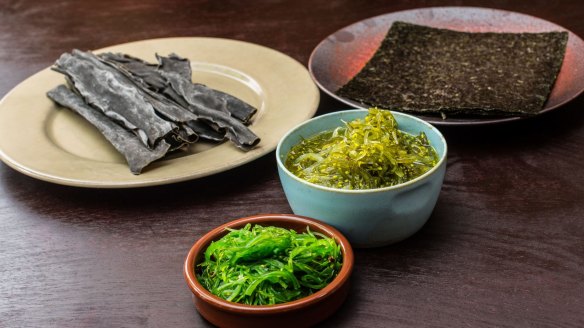Nori, kombu, wakame: Everything you need to know about cooking with seaweed

What is it?
While seaweed is a culinary staple in Eastern and Celtic cuisines it is becoming popular in the modern kitchen as a sustainable, nourishing food.
Seaweed is edible algae, a plant that grows underwater. Some is harvested and sold fresh, but most are dried.
One of the most common is nori, which has been chopped, rolled and dried into sheets used to wrap sushi.
Wakame, sometimes called sea lettuce, is a green and slightly chewy seaweed and is sold fresh, dried and frozen.
Dried kelp, or kombu, is an essential ingredient in Japanese dashi and is found dried in strips.
Why do we love it?
Packed with nutrients such as vitamins A, B, E and K, and iodine and folate, many seaweeds contain more than their share of glutamic acids, making them buzz with the sense of deliciousness the Japanese call umami.
Most dried seaweeds are rehydrated, offering the taste of the sea in every bite, and when fresh or rehydrated, a superbly slippery texture.
Who uses it?
"Australian Indigenous people ate and used seaweed for thousands of years," says Byron Bay chef David Moyle. "From kelp footwear to cooking and eating it, the coastal people made seaweed a big part of their life. It's crazy we don't do more with it."
Moyle has cooked kelp with eel to celebrate the Gunditjmara Budj Bim eel culture for the Melbourne Food and Wine Festival.
How do you use it?
NORI
- Moyle toasts nori in the oven at 80C for 5-10 minutes until crisp, blends it with enough rice wine vinegar, mirin and sesame oil to make a smooth seaweed dressing, perfect for roasted vegetables and wood-grilled cabbage.
- Cooking school owner and chef Tony Tan crumbles toasted nori sheets in his hands and stirs it into cooked jasmine rice, along with toasted sesame seeds and fine strips of makrut lime leaves.
- Blend toasted nori with salt in a food processor to make flavour-enhancing salt.
- Make nori cones and fill with tuna tartar and top with salmon caviar and togarashi.
WAKAME
Wakame can be bought frozen, pickled or dried. Use as a vegetable and add to stir-fries, blanch and serve with oil and lemon juice as you would spinach, or shred and make a cold salad with sesame oil.
Roast wakame with a little salt and oil and serve as wakame chips.
KOMBU
Kelp or kombu is rich in glutamic acid and forms the basis of dashi stock, used to make miso soup and clear broth, along with dried tuna flakes. Use a little dried kelp as a vegan stock cube in soups and stews.
Where do you get it?
Supermarkets carry dried and roasted nori sheets, while Japanese grocers such as FujiMart, Prahran (Vic), or Tokyo Mart, Northbridge (NSW), carry wakame and kombu. Tasmanian wakame is sold online at ashmorefoods.com.au.
